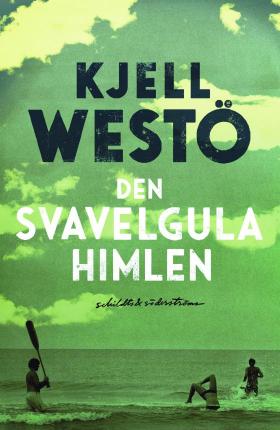
Den svavelgula himlen
(The Sulphur-Yellow Sky)
by Kjell Westö
reviewed by Kate Lambert
Den svavelgula himlen begins with an unnamed narrator, a writer, in his house overlooking the sea. Trying to write about a topic he knows too little about, he feels he is being watched. As a novelist, he has spent his life observing others. Is someone observing him? Amid a sense of increasing menace, he shines a torch from the balcony. A shadow vanishes into the trees. Two weeks later, his childhood friend Alex Rabell is stabbed in the street and the press explodes with stories, rumours and scandals about the Rabells, members of Finland’s Swedish-speaking elite.
From this point in the not-quite present, the narrative jumps back to 1969 and the childhood meeting between the narrator, whose father works in a white goods shop, and the rich, privileged Rabell family. Virtually adopted by them, the narrator later compares himself to Nick Carraway in The Great Gatsby. The long, hot summers at Ramsvik, the Rabells’ summer home on the Gulf of Finland, are intensely evoked, and with them the narrator’s teenage passion for Alex’s sister Stella, a love that will last a lifetime, forged under the sulphur-yellow sky of the title.
Over the next three hundred or so pages, the narrator describes the intertwined lives of himself and Stella, the charming, manipulative and ruthless Alex Rabell, and their classmates: the bullied Krister Tuominen; Klasu Hjelt, later employed by Alex; Jan-Roger Johansson, who becomes Alex’s hired muscle; and Linda Vogt, to whom the narrator returns each time his relationship with Stella falls apart. Their lives are shaped by class, their parents’ and grandparents’ pasts – which, for this generation of Finns, were affected by the atrocities of war – and the things their families do not talk about that reverberate unspoken through their generation and on to the next. In the background are global political events, ranging from the Baader-Meinhof gang in the 1970s to Chernobyl, the fall of the Berlin Wall, 9/11, the refugee crisis and the Charlie Hebdo massacre.
Kjell Westö’s international breakthrough came with Där vi en gang gått (Where We Once Walked) in 2006, which won the Finlandia Prize and was translated into many major European languages. His previous novel, Hägring 38, published in English as The Wednesday Club, was shortlisted for the Petrona Award for best Scandinavian Crime Novel 2017. Although Den svavelgula himlen begins with a crime, and the momentum of the novel comes from the four decades leading up to it, it is not about uncovering a mystery. More than that, it asks how complicit are those who watch, who are involved but not involved, who see but do nothing. On holiday in Spain, a friend of Stella’s agrees to buy her 12-year-old son a Guantanamo Bay T-shirt and is challenged by a waiter. ‘You should have said no’, he tells Stella and the narrator. At school the narrator watched Jan-Roger beat up Krister Tuominen at Alex’s silent behest. Linda was the only bystander to call a halt.
The narrative is detached, seen through the eyes of the always nameless narrator, but that may be the point. As Stella Rabell puts it, quoted on the frontispiece, ‘the feeling of déjà vu is merely a kind of anxiety about the unreality of life’. Despite being a professional observer, late in life the narrator wonders whether he can trust his memory. There are key aspects that he has failed to notice in his mental account of the past and one event he misremembers entirely, displacing his own guilt. Others remember things differently. Whose reality is real? Can he trust his memory? Can we? He concludes that it is love that makes us remember but, in the last line, asks himself: what is it that we remember, and what is it that we actually love?

Den svavelgula himlen
Schildts & Söderströms, 2017. 470 pp.
